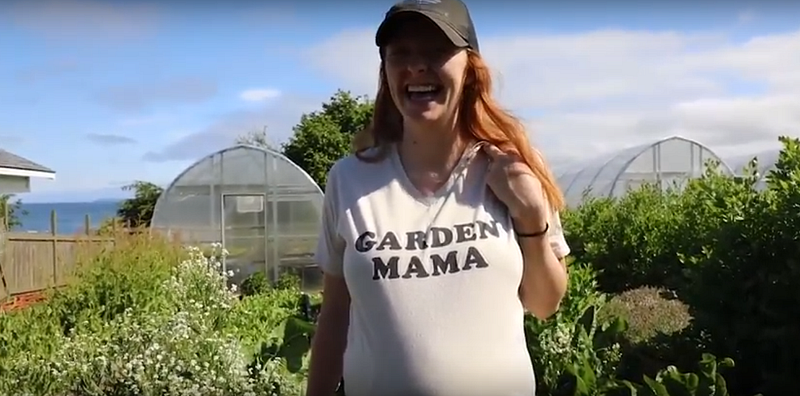Farming for a Feast
Story and video by RACHEL POSTLEWAIT
Restaurant and farm collaborations provide the ultimate dining experience — but what really goes into it?
[embed]https://www.youtube.com/watch?v=qfWnuQvZqMM[/embed]
The journey to Lummi Island could only be described as magical. Bellingham’s never-ending rain and clouds parted for one glorious day in May. I felt transported into a serene alternate reality of sunshine. After a drive along the lush edges of the island, I arrived at a white carport lined with gardening tools, parallel to a picturesque and expertly landscaped family home. Four white domes were visible in the distance — the greenhouses. Across the road, almost-hidden wooden stairs beckon you down to the private sandy beach.
A hand perked up from afar and waved to me — Mary von Krusenstiern, manager of the Loganita Farm. I walked through the grass toward the enclosed garden, breathing in the warm, sweet air. She wrapped up her part of a tour given to some visitors of The Willows Inn — the restaurant which Loganita exclusively grows produce for. Mary had a welcoming presence to her. A baseball hat shielded her face, but an ear peeked out of her brown hair lightened by the sun. Her tall, brown rubber boots were splattered with mud and her soil-lined hands visibly showed her profession. She wore it proudly.
The farm and restaurant are on Lummi Island, which sits in the southwest corner of Whatcom County, a 50-minute drive and a quick six-minute ferry ride from Bellingham. Mary, originally from Bellingham, now lives and commutes from Glacier, Washington. She works Monday through Thursday every week running the farm, often bringing her 2-year-old son, Trell (named after chanterelle mushrooms) with her.
She has been working on small scale, diversified organic farms since 2005. Having visited Lummi growing up, Mary said she has fond memories of the island. After spotting a job posting online a few years ago, she jumped at the occasion.
We walked into the first greenhouse where sectioned trays of soil hosting the various plants sat atop metal tables. Anything from tender greens to okra and eggplant begin their journey in this seed germination room. From there, they are transplanted into bigger containers, sometimes graduating to the big field.
Mary’s duties, along with the four other female gardeners, revolve around providing and planning for the restaurant. “I’m in the dirt as much as I am at my desk figuring out the right time to plant the Caraflex cabbage so it will coincide with the tuna harvest in early July.”

The buzzing of the fans from the first greenhouse subsided as we strolled to the next few. These house more mature, larger plants, which sit in raised beds.
The farmers often experiment with different varieties to accommodate the ever-evolving menus. Mary casually yanked one experiment, a red Japanese turnip, from the dirt.
Down the road from the farm, the 100-year-old restaurant is home to world-renowned Chef Blaine Wetzel. Before coming to Willows in 2010, he worked at Noma restaurant in Copenhagen for several years where he encountered the hyper-local style he has since brought to Willows.
Chef Blaine was listed by Food & Wine magazine as the Best New Chef of 2012. He received the James Beard Rising Star Chef of the Year in 2014, and in 2015, was awarded Best Chef Northwest. This all occurred while he was in his 20s. The restaurant was listed on Eater’s Best Restaurants in America.
For $225 at Willows, you can experience a prix-fixe tasting menu that often boasts 20-plus courses, with standouts such as elk tartare with wild herbs and rye bread, whole barbecued lamb with rosemary and anchovy, and overwintered rutabagas with caramelized razor clams. People visit from all over the world to dine on these treasures of the San Juan Archipelago.
And where do many of these raw ingredients come from? Loganita. The highly adorned Chef Blaine wouldn’t receive the same recognition or be able to produce the same desirable dishes without his farmer.
“I always tell people that if our chefs called up a local farmer and asked them to deliver 300 nasturtium leaves the size of a dime, the farmer would hang up the phone,” Mary said. “Because our farm is dedicated to the restaurant, we can cater to their exact needs.”
Beyond the greenhouses were at least 15 raised beds and two full-sized fields. Mary lifted some row-covers, checking on the growth. She knelt by a raised bed and began cutting the Claytonia greens to be used in a multitude of dishes.
Ultimately, farms provide food to be manipulated in some way. Their consumers range from giant corporations to restaurants to a household. Farms can be a small backyard or a rooftop; they can focus on growing one product or they can have thousands of acres and provide for the food production industry.
However they exist, we are all impacted by them. Whether it’s those chips you’re eating, made with corn grown in some rural part of Iowa, or those carrots you bought at the farmers market. We need our farms to survive and to thrive.
